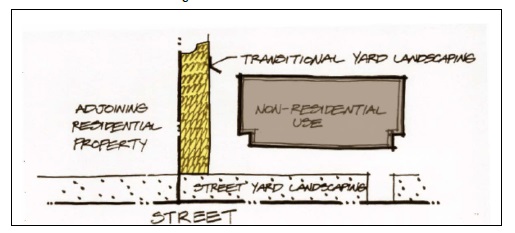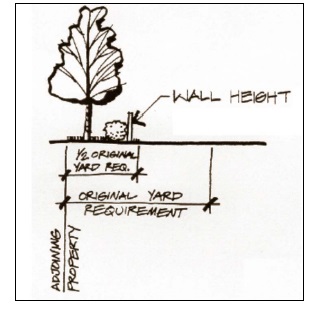(A) Buffering standards.
(1) Applicability. Undeveloped properties, expansions of more than 40% of existing floor area, and rezoned property are subject to the provisions of this section. Developed lots or lots with unexpired permits at the effective date of this chapter are hereby exempt from this requirement.
(2) Buffer yard requirement. Where a commercial office, commercial neighborhood, public/semi-public or multifamily use directly abuts a single-family or two-family residential use, or an industrial use directly abuts a commercial use, the subject property shall provide a landscape buffer 20 feet wide planted with five trees and ten ornamental shrubs per 100 lineal feet of buffer yard, and undulating mounding of at least three feet in height between the conflicting uses. Where an industrial use or commercial regional use directly abuts any residential use or public/semi-public use, the subject property shall provide a landscape buffer 30 feet wide planted with eight trees and ten ornamental shrubs per 100 lineal feet of buffer yard, and mounding of at least five feet in height with a minimum six-foot fence constructed on top of the mounding between the conflicting uses. The fence shall be constructed of 100% brick and/or stone, or brick or stone columns with wood or wood-like composite material between the columns (spaced no more than 50 foot on center). One hundred percent of the required shrubs and at least 50% of the required trees must be located between the fence and the residential, institutional, or public/semi-public use. It shall be the responsibility of the new land use creating the incompatibility to construct and maintain the landscape buffer. Where an industrial use is not immediately adjacent to a single-family or two-family use, but is separated from the residential use by only public right-of-way, the industrial land use shall provide a landscape buffer 30 feet wide planted with eight trees and ten ornamental shrubs per 100 lineal feet of buffer yard, and mounding of at least five feet in along the adjoining right-of-way. This buffer yard can be waived by the Administrative Officer if the property owner of the neighboring lower-intensity use requests, in writing to the Administrative Officer, to not have the buffer yard constructed along their property line.
(3) Buffer yard width reduction provision. The width of the required buffer and the number of shrubs may be reduced by half with the construction of an opaque wall or fence. The fence or wall shall be opaque (solid) and constructed of material compatible with the principle building in composition and color. The wall shall have a minimum height of five feet and a maximum height of seven feet.
(B) Screening of loading and storage areas. Screening shall be by opaque wall or fence six to eight feet in height. One-third of the surface area of the wall or fence must be screened from an existing or planned public right-of-way with plants within six months of the date of the occupancy permit being issued. Screening shall be evergreen, and planted at a maximum spacing of four feet on center.
Figure 12: Buffer Yard Location

Figure 13: Buffer Yard Example

(Ord. 121410, passed 1-11-2011; Ord. 111114, passed 11-11-2014; Ord. 111020C, passed 12-8-2020)